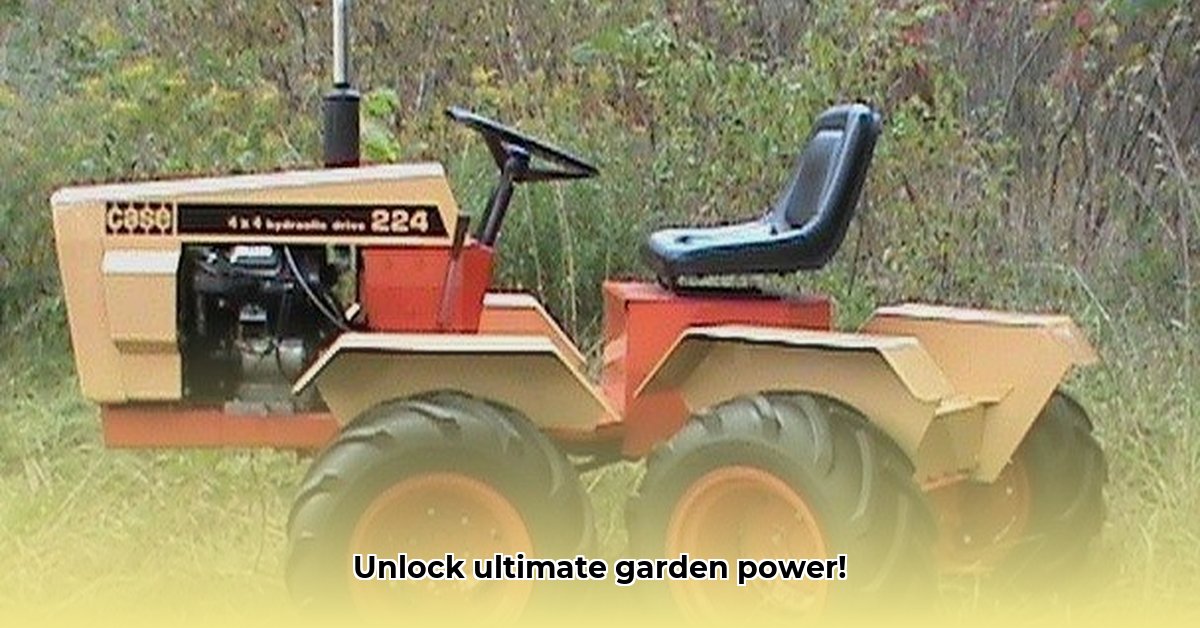
4x4 Garden Tractors: Power and Precision for Your Lawn
Tired of wrestling with a lawnmower on uneven terrain? A 4x4 garden tractor offers superior power and maneuverability, making yard work simpler and more efficient. This guide helps you navigate the market, choose the right model, and maintain it for years of reliable service. We'll also explore sustainable lawn care practices to minimize your environmental footprint. For extra help with attachments, check out this guide on box blade attachments.
Sizing Up Your Needs: Property, Budget, and Terrain
Before diving into models, assess your property. A small, flat yard requires a different tractor than a large, hilly landscape. Measure your property, noting slopes, obstacles, and the overall area. This will determine the necessary engine power and cutting deck size. Establish a realistic budget; higher-end models offer advanced features, but a basic model might suffice for smaller properties. Remember to factor in costs for attachments (snow plow, tiller, etc.) and potential maintenance. Are you cutting grass that needs a higher-powered tractor?
Key Features of High-Performance 4x4 Garden Tractors
The core advantage of a 4x4 tractor is, of course, its all-wheel drive. This provides superior traction on slopes, uneven ground, and wet grass, preventing slippage and increasing safety. Beyond the 4x4, several key features differentiate models:
Engine Power (Horsepower): Higher horsepower enables easier mowing, especially in tough conditions, and allows for using various attachments without straining the engine. But more horsepower doesn't always mean better fuel economy. Consider your property's challenges - higher horsepower may be necessary for steeply sloped or heavily overgrown areas.
Cutting Deck Size: This directly affects mowing speed and efficiency. Larger decks cover more ground per pass but typically require a more powerful engine. Choose a size appropriate for your yard size and the tractor's horsepower.
Attachment Compatibility: Decide what attachments you'll need now and in the future (e.g., tiller, snow plow). Ensure your chosen tractor is compatible with these attachments. The availability of readily available, affordable parts should also be a consideration.
Build Quality: Look for sturdy construction. A durable tractor will last longer and withstand years of use.
Choosing Your Tractor: A Step-by-Step Guide
Assess Your Property: Measure and map your lawn, noting slopes, obstacles, and challenging areas.
Establish Your Budget: Set a realistic budget that includes the tractor, necessary attachments, and maintenance.
Research Tractor Models: Compare specs, features, and user reviews from multiple sources.
Consider Attachments: Determine any attachments you need, now and in the future, and ensure compatibility.
Read Reviews: Consult several independent reviews to gain a balanced perspective on different models.
Test Drive (if possible): A test drive allows you to assess handling, power, and comfort.
Make Your Purchase: After thorough research, choose the tractor that best fits your needs and budget.
Maintaining Your 4x4 Garden Tractor: Tips for Longevity
Regular maintenance is vital for optimal performance and a longer lifespan. This includes:
Oil Changes: Follow the manufacturer's recommended oil change schedule for your tractor's engine; this ensures smooth operation and prevents engine damage.
Air Filter Cleaning/Replacement: A clean air filter improves engine efficiency and avoids unnecessary fuel consumption.
Blade Sharpening: Sharp blades result in a clean cut and prevent scalping, which can stress your lawn.
Tire Pressure: Maintain proper tire pressure for optimal traction and performance.
Regular Inspections: Give your tractor a quick check before each use to spot potential problems early.
Safety First: Operating Your Tractor Safely
Prioritize safety while operating your tractor:
Read the Owner's Manual: Familiarize yourself with all safety instructions before operating the machine.
Wear Protective Gear: Always wear safety glasses, hearing protection, and sturdy, closed-toe shoes.
Remain Alert: Be aware of your surroundings, especially children and pets, and maintain a safe distance from the discharge chute.
Avoid Intoxication: Never operate the tractor under the influence of alcohol or drugs.
Sustainable Lawn Care Practices
Even powerful machines can be used responsibly. Minimize fuel consumption by:
Avoiding Over-Mowing: Over-mowing stresses the lawn and increases fuel consumption. Mow at the recommended height for your grass type.
Efficient Mowing Techniques: Minimize overlapping passes to reduce fuel usage without sacrificing cut quality. Strategic mowing patterns improve efficiency.
Using Fuel-Efficient Models: Choose tractors with fuel-efficient engines wherever possible.
Proper Maintenance: Regular maintenance maximizes fuel efficiency and minimizes environmental impact.
Data Limitations: Acknowledging the Gaps
Comprehensive, independent testing data on 4x4 garden tractors remains limited. This guide relies on manufacturer specifications, user reviews, and general best practices. Future research will likely provide more detailed comparative data. Always supplement information from multiple reliable sources.
High-Performance Lawn Tractor Fuel Efficiency: A Deeper Dive
Fuel efficiency is a critical factor in tractor ownership. While horsepower is essential, it's not the sole indicator of fuel economy. Factors such as engine type (V-twin vs. single-cylinder), torque (crucial for hills and thick grass), and deck size impact fuel consumption considerably. A higher torque engine might be more fuel efficient at lower RPMs, saving you money on fuel over time. Independent testing data, though limited, can inform these comparisons.
A higher-torque engine may be more efficient at lower RPMs, even with similar horsepower. Consider the long-term cost of fuel when comparing models and prioritize models that balance power with fuel efficiency. Also consider the cost and accessibility of parts for long-term maintenance, as this greatly affects the overall cost of ownership.
Key Considerations:
- Your property's size and terrain directly influence the necessary tractor power and features.
- Thorough research, including user reviews, is vital for informed decision-making.
- Regular maintenance significantly impacts fuel efficiency and prolongs the tractor's life.
- Practice sustainable mowing techniques to reduce fuel consumption and environmental impact.
Remember to consult multiple sources and prioritize safety in every aspect of tractor operation and maintenance.